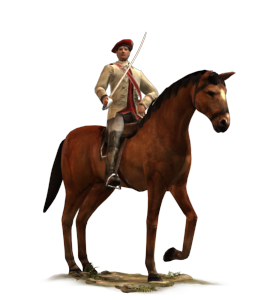Difference between revisions of "Yeomanry (ETW Unit)"
Fire-dweller (talk | contribs) (→Factions) |
Tango12345 (talk | contribs) m (Removed category "Empire Total War Units"; Quick-adding category "ETW Units" (using HotCat)) |
||
| (7 intermediate revisions by 5 users not shown) | |||
| Line 1: | Line 1: | ||
| − | {{Unit|image=[[Image:Yeomanry.jpg]]|Class=Cavalry| | + | {{TW Unit|image=[[Image:Yeomanry.jpg]] |
| + | |Class=Cavalry | ||
| + | |Unit Size=60 Men | ||
| + | |Weaponry=Sabers | ||
| + | |Region=Europe | ||
| + | |Recruitment Cost=900 | ||
| + | |Upkeep Cost=270 | ||
| + | |Building Requirements=Governers Residence | ||
| + | |Tech Requirements=None | ||
| + | |Attributes=<li>Can Hide in Woodland</li> | ||
| + | <li>Can form Diamond Formation</li> | ||
| + | <li>Can Form Wedge Foramtion</li> | ||
| + | }} | ||
| + | |||
| + | [[Image:Provincinal_Cavalry_Thumb.png]] These locally recruited cavalry are a valuable aid in keeping order. | ||
==Overview== | ==Overview== | ||
| Line 8: | Line 22: | ||
Historically, there are many examples of yeomanry or gendarmes turning on their own citizenry with surprising and horrific violence. They were widely used against the anti-factory Luddites in northern England and, most infamously, were responsible for the Peterloo Massacre in 1819, when the Manchester and Salford Yeomanry charged a mostly peaceful, but excited crowd, and cut down many unarmed protesters. | Historically, there are many examples of yeomanry or gendarmes turning on their own citizenry with surprising and horrific violence. They were widely used against the anti-factory Luddites in northern England and, most infamously, were responsible for the Peterloo Massacre in 1819, when the Manchester and Salford Yeomanry charged a mostly peaceful, but excited crowd, and cut down many unarmed protesters. | ||
| + | |||
| + | ==Details== | ||
| + | |||
| + | Yeomanry are quite similar to [[Provincial Cavalry (ETW Unit)| Provincial Cavalry]] and should be treated as such. Yeomanry are useful for settling unrest in local settlements, especially late game. However they field fairly low melee statistics and so should not be relied upon to combat stronger units. They are best suited to combating weak or wavering units. | ||
==Factions== | ==Factions== | ||
| − | |||
| − | [[Category:Cavalry]] | + | *[[Image:Britain_flag.jpg|25px]] [[Great Britain (ETW Faction)|Great Britain]] |
| + | |||
| + | [[Category:ETW Cavalry]] | ||
| + | [[Category:ETW Units]] | ||
Latest revision as of 09:51, 30 May 2017
 These locally recruited cavalry are a valuable aid in keeping order.
These locally recruited cavalry are a valuable aid in keeping order.
Overview
These light horsemen are often little more than mounted militia, but with a greater social standing. Cavalry always see themselves as better than foot soldiers, but in this case, it may be true. It is, after all, not cheap to purchase and maintain a decent horse, and this means that men with financial standing make up the majority of recruits.
They are, however, not as disciplined as regular cavalry, simply because they do not have the time or available resources to learn the craft of war as thoroughly. They are, however, extremely useful in policing the rougher, lower orders and keeping the existing social structure intact.
Historically, there are many examples of yeomanry or gendarmes turning on their own citizenry with surprising and horrific violence. They were widely used against the anti-factory Luddites in northern England and, most infamously, were responsible for the Peterloo Massacre in 1819, when the Manchester and Salford Yeomanry charged a mostly peaceful, but excited crowd, and cut down many unarmed protesters.
Details
Yeomanry are quite similar to Provincial Cavalry and should be treated as such. Yeomanry are useful for settling unrest in local settlements, especially late game. However they field fairly low melee statistics and so should not be relied upon to combat stronger units. They are best suited to combating weak or wavering units.
